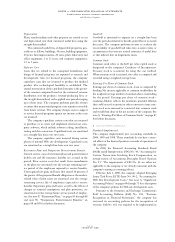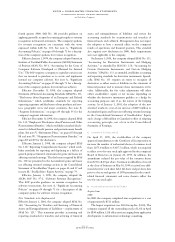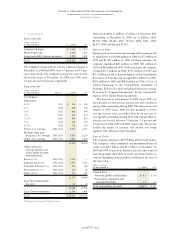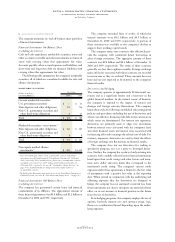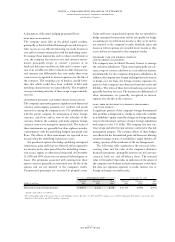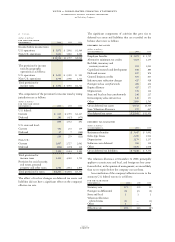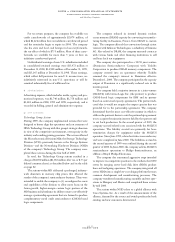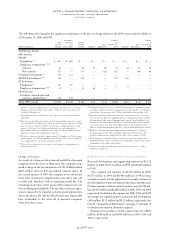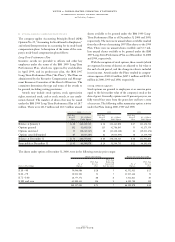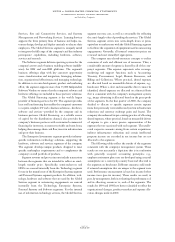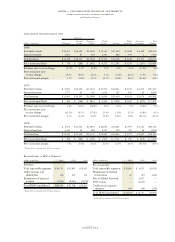IBM 2000 Annual Report Download - page 83
Download and view the complete annual report
Please find page 83 of the 2000 IBM annual report below. You can navigate through the pages in the report by either clicking on the pages listed below, or by using the keyword search tool below to find specific information within the annual report.
page no.
eighty-one
notes to consolidated financial statements
international business machines corporation
and Subsidiary Companies
For tax return purposes, the company has available tax
credit carryforwards of approximately $2,079 million, of
which $1,424 million have an indefinite carryforward period
and the remainder begin to expire in 2004. The company
also has state and local, and foreign tax loss carryforwards,
the tax effect of which is $735 million. Most of these carry-
forwards are available for more than 5 years or have an
indefinite carryforward period.
Undistributed earnings of non-U.S. subsidiaries included
in consolidated retained earnings were $15,472 million at
December 31, 2000, $14,900 million at December 31, 1999,
and $13,165 million at December 31, 1998. These earnings,
which reflect full provision for non-U.S. income taxes, are
indefinitely reinvested in non-U.S. operations or will be
remitted substantially free of additional tax.
PADVERTISING
Advertising expense, which includes media, agency and pro-
motional expenses, was $1,746 million, $1,758 million and
$1,681 million in 2000, 1999 and 1998, respectively, and is
recorded in Selling, general and administrative expense.
Q1999 ACTIONS
Technology Group Actions
During 1999, the company implemented actions that were
designed to better align the operations and cost structure of
IBM’s Technology Group with that group’s strategic direction
in view of the competitive environment, overcapacity in the
industry and resulting pricing pressures. The actions affected
the Microelectronics Division (MD), the Storage Technology
Division (STD)
—
previously known as the Storage Systems
Division
—
and the Networking Hardware Division (NHD)
of the company’s Technology Group. The company com-
pleted these actions during the first half of 2000.
In total, the Technology Group actions resulted in a
charge of $1,690 million ($1,366 million after tax, or $.73 per
diluted common share) as described below and in the table
on page 82.
The actions within MD addressed a prolonged, industry-
wide downturn in memory chip prices that affected the
results of the company’s semiconductor business. They were
intended to enable the company to (1) reconfigure the assets
and capabilities of the division to allow more focus on the
faster-growth, higher-margin custom logic portion of the
MD business and (2) enhance its ability to more cost-effectively
manage a partnership agreement that was formed to produce
complementary metal oxide semiconductor (CMOS) based
logic components.
The company reduced its internal dynamic random
access memory (DRAM) capacity by converting its manufac-
turing facility in Essonnes, France, from DRAM to custom
logic. The company effected that conversion through a joint
venture with Infineon Technologies, a subsidiary of Siemens
AG. Also related to DRAM, the company executed contracts
with various banks and other financing institutions to sell
and lease back test equipment.
The company also participated in a 50/50 joint venture
(Dominion Semiconductor Company) with Toshiba
Corporation to produce DRAM memory components. The
company entered into an agreement whereby Toshiba
assumed the company’s interest in Dominion effective
December 1, 2000. The company participated in the capacity
output of Dominion at a significantly reduced rate in the
interim period.
The company held a majority interest in a joint venture
(MiCRUS) with Cirrus Logic Inc. (the partner) to produce
CMOS-based logic components for IBM and its partner
based on contractual capacity agreements. The partner indi-
cated that it would not require the output capacity that was
provided for in the partnership agreement. The company
determined that the most cost-effective manner in which to
address the partner’s desire to exit the partnership agreement
was to acquire the minority interest held by that partner and
to cut back production. In the second quarter of 1999, the
company accrued related costs associated with the MiCRUS
operations. The liability created was primarily for lease
termination charges for equipment under the MiCRUS
operation. Since June 1999, related activities were under way
and were completed in June 2000. The liabilities accrued in
the second quarter of 1999 were utilized during the second
quarter of 2000. In June 2000, the company sold its MiCRUS
semiconductor operations to Philips Semiconductors, an
affiliate of Royal Philips Electronics.
The company also announced aggressive steps intended
to improve its competitive position in the markets that STD
serves by merging server hard disk drive (HDD) product
lines and realigning operations. The company integrated all
server HDDs into a single low-cost design platform that uses
common development and manufacturing processes. The
company transferred manufacturing assembly and test oper-
ations to Hungary and Mexico and completed these actions
by mid 2000.
The actions within NHD relate to a global alliance with
Cisco Systems, Inc. As a result of the announcement of the
alliance, demand for the router and switch products by both
existing and new customers deteriorated.


